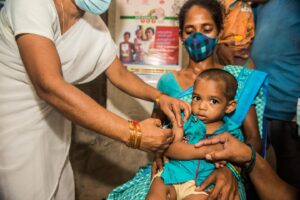GS2 – Social Sector

Context:
India has 1.44 million zero-dose children, the second highest globally after Nigeria, as per The Lancet (2023), highlighting serious immunisation coverage gaps.
- As per WHO, zero-dose children are under one year of age who have received no routine vaccines.
- These children are vulnerable to diseases such as measles, polio, and diphtheria.
Why It Matters:
- Herd Immunity Risk: They reduce overall community protection, affecting disease eradication.
- COVID-19 Impact: The pandemic disrupted immunisation programs, causing a surge in zero-dose cases. Recovery efforts are ongoing but still below pre-pandemic levels.
- Beyond Infancy: This metric doesn’t cover older or partially vaccinated children who are also at high risk.
Structural Challenges:
- Geographic Clustering: Found in urban slums, conflict-affected zones, and isolated areas with weak public health services.
- Awareness and Access: Parents in these communities lack information or ability to access vaccination services.
- Documentation Hurdles: The U-WIN platform requires mobile access and identity proof like Aadhaar—often unavailable to marginalized groups.
- Post-Pandemic System Lag: Immunisation efforts sidelined during COVID-19 have yet to fully recover.
Government Interventions:
- Mission Intensified Indradhanush: Expands coverage in priority districts via focused drives.
- Catch-Up Drives: Aims to vaccinate older children who missed initial doses.
- Door-to-Door Campaigns: Particularly effective in remote and market-based outreach in North-East India.
- Zero-Dose Implementation Plan: Focused on 143 vulnerable districts across 11 states.
Way Forward:
- Strengthen Last-Mile Delivery: Enhance access in underserved regions.
- Expand Target Group: Include partially vaccinated and older unvaccinated children.
- Integrated Approach: Link immunisation to other health services like nutrition and sanitation.
- Improve Digital Access: Make platforms like U-WIN inclusive of offline and undocumented populations.
- Boost Community Awareness: Use local influencers and civil society to increase vaccine literacy and trust.




